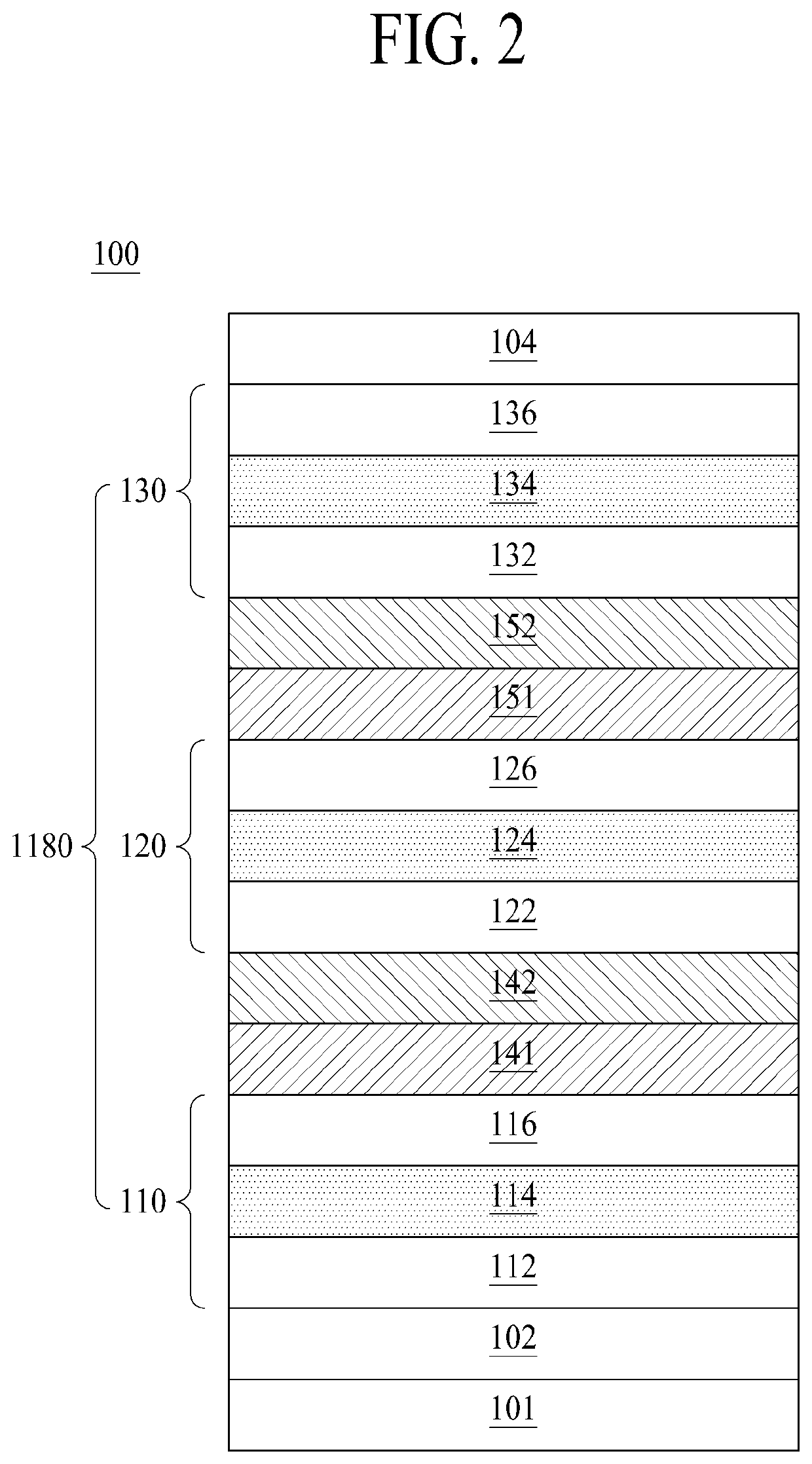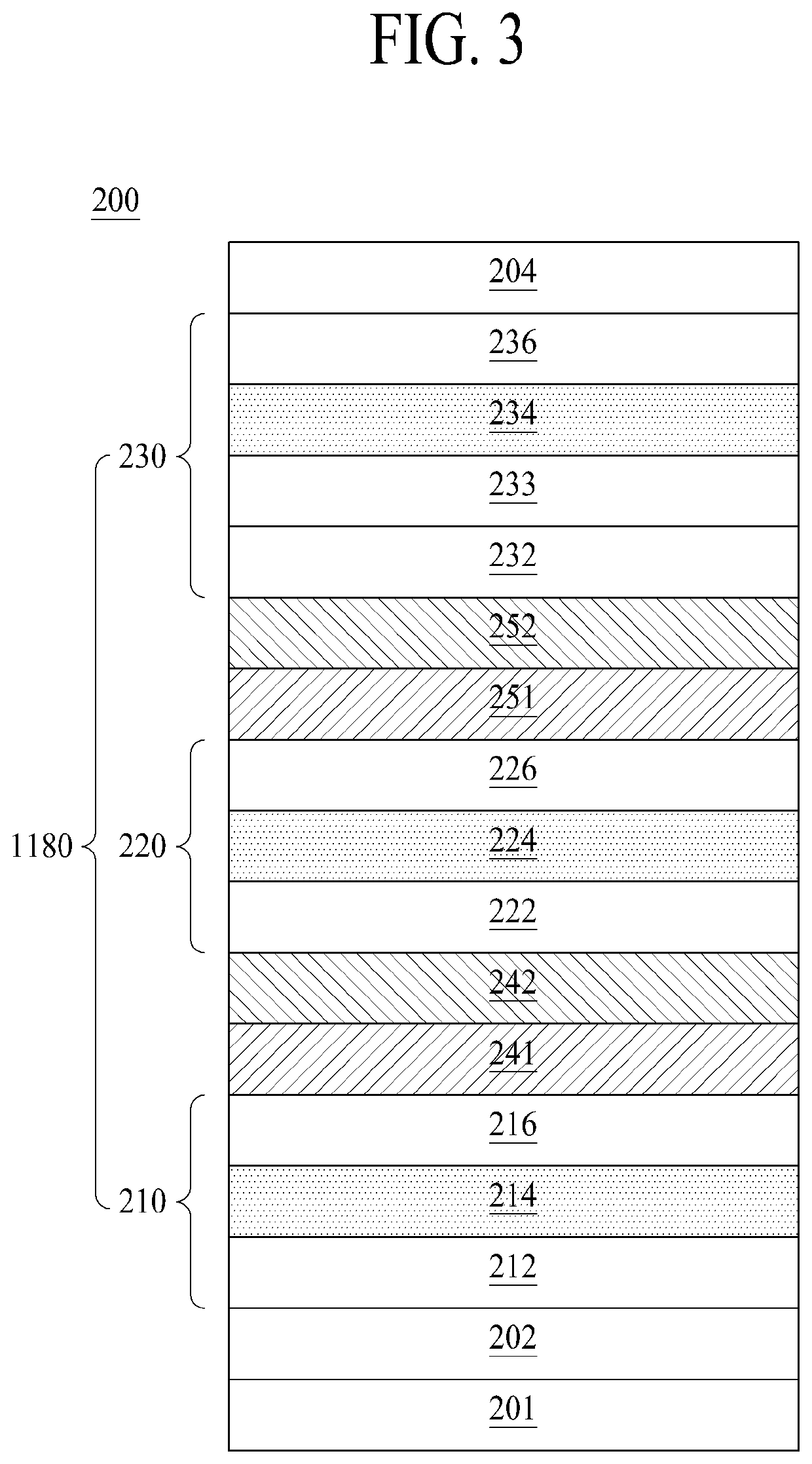Organic light emitting display device (OLED) having p-type charge generation layer (CGL) formed between emissions stack
a light-emitting display device and emission stack technology, applied in the direction of organic semiconductor devices, solid-state devices, semiconductor devices, etc., can solve the problems of degrading the reliability of organic light-emitting devices, and the manufacturing cost of organic light-emitting display devices cannot be reduced, so as to improve efficiency or lifetime, reduce driving voltage, and enhance efficiency or lifetime
- Summary
- Abstract
- Description
- Claims
- Application Information
AI Technical Summary
Benefits of technology
Problems solved by technology
Method used
Image
Examples
first embodiment
[0051]FIG. 2 is a diagram illustrating an organic light emitting device 100 according to the present disclosure.
[0052]The organic light emitting device 100 illustrated in FIG. 2 may include a substrate 101, a first electrode 102, a second electrode 104, and an emission part 1180 between the first and second electrodes 102 and 104. The emission part 1180 may include a first emission part 110, a second emission part 120, and a third emission part 130.
[0053]The substrate 101 may be formed of an insulating material or a material having flexibility. The substrate 101 may be formed of glass, metal, plastic, and / or the like, but is not limited thereto. If an organic light emitting display device is a flexible organic light emitting display device, the substrate 101 may be formed of a flexible material such as plastic and / or the like. Also, if an organic light emitting device which is easy to realize flexibility is applied to a lighting device for vehicles, various designs and a degree of f...
second embodiment
[0118]FIG. 3 is a diagram illustrating an organic light emitting device 200 according to the present disclosure.
[0119]The organic light emitting device 200 illustrated in FIG. 3 may include a substrate 201, a first electrode 202, a second electrode 204, and an emission part 1180 between the first electrode 202 and the second electrode 204. The emission part 1180 may include a first emission part 210, a second emission part 220, and a third emission part 230. The substrate 201, the first electrode 202, the second electrode 204, and the first emission part 210 illustrated in FIG. 3 may be substantially the same as the substrate 101, the first electrode 102, the second electrode 104, and the first emission part 110 described above with reference to FIG. 1, and thus, their detailed descriptions are not provided herein or will be brief.
[0120]The first emission part 210 may include a first HTL 212, a first EML 214, and a first ETL 216 which are disposed on the first electrode 202.
[0121]Th...
third embodiment
[0172]FIG. 4 is a diagram illustrating an organic light emitting device 300 according to the present disclosure.
[0173]The organic light emitting device 300 illustrated in FIG. 4 may include a substrate 301, a first electrode 302, a second electrode 304, and an emission part 1180 between the first electrode 302 and the second electrode 304. The emission part 1180 may include a first emission part 310, a second emission part 320, and a third emission part 330. The substrate 301, the first electrode 302, the second electrode 304, and the first emission part 310 illustrated in FIG. 4 may be substantially the same as the substrate 101, the first electrode 102, the second electrode 104, and the first emission part 110 described above with reference to FIG. 1, an d thus, their detailed descriptions are not provided herein or will be brief.
[0174]The first emission part 310 may include a first HTL 312, a first EML 314, and a first ETL 316 which are disposed on the first electrode 302.
[0175]A...
PUM
| Property | Measurement | Unit |
|---|---|---|
| thickness | aaaaa | aaaaa |
| LUMO energy level | aaaaa | aaaaa |
| HOMO energy level | aaaaa | aaaaa |
Abstract
Description
Claims
Application Information
 Login to View More
Login to View More - R&D
- Intellectual Property
- Life Sciences
- Materials
- Tech Scout
- Unparalleled Data Quality
- Higher Quality Content
- 60% Fewer Hallucinations
Browse by: Latest US Patents, China's latest patents, Technical Efficacy Thesaurus, Application Domain, Technology Topic, Popular Technical Reports.
© 2025 PatSnap. All rights reserved.Legal|Privacy policy|Modern Slavery Act Transparency Statement|Sitemap|About US| Contact US: help@patsnap.com



